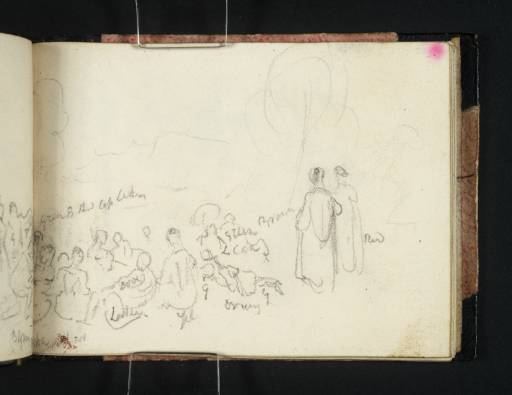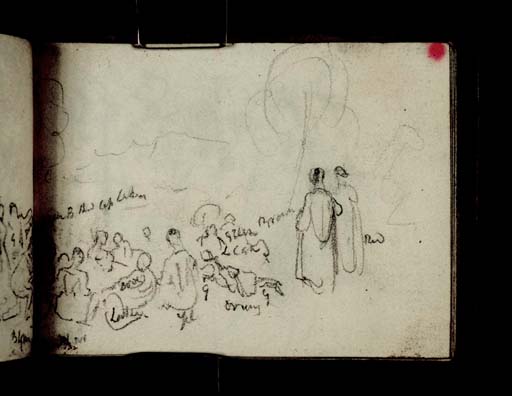Joseph Mallord William Turner Partial Copy of 'The Enchanted Isle' by Antoine Watteau c.1815-18
Image 1 of 2
Joseph Mallord William Turner,
Partial Copy of 'The Enchanted Isle' by Antoine Watteau
c.1815-18
Joseph Mallord William Turner 1775–1851
Folio 26 Verso:
Partial Copy of ‘The Enchanted Isle’ by Antoine Watteau circa 1815–18
D10629
Turner Bequest CXLI 26a
Turner Bequest CXLI 26a
Pencil on white wove paper, 88 x 114 mm
Inscribed by Turner in pencil with colour notes ‘green B Red Cap’, ‘Yel]low]’, ‘Green’ ‘Brown’, ‘Red’ &c within image
Inscribed by Turner in pencil with colour notes ‘green B Red Cap’, ‘Yel]low]’, ‘Green’ ‘Brown’, ‘Red’ &c within image
Accepted by the nation as part of the Turner Bequest 1856
References
1909
A.J. Finberg, A Complete Inventory of the Drawings of the Turner Bequest, London 1909, vol.I, p.406, CXLI 26a, as ‘group of figures: possibly copy of a Watteau; and two studies for pictures’.
1971
Jerrold Ziff, ‘review of John Gage, Colour in Turner, 1969’, The Art Bulletin, vol.53, 1971, pp.125–6.
1974
Gerald Wilkinson, The Sketches of Turner, R.A. 1802–20; Genius of the Romantic, London 1974, p.174 reproduced.
1974
Martin Butlin, Andrew Wilton and John Gage, Turner 1775–1851, exhibition catalogue, Royal Academy, London 1974, p.78.
1979
Andrew Wilton, The Life and Work of J.M.W. Turner, Fribourg 1979, p.134 note 40.
1983
John Gage, in Gage, Jerrold Ziff, Nicholas Alfrey and others, J.M.W. Turner, à l’occasion du cinquantième anniversaire du British Council, exhibition catalogue, Galeries nationales du Grand Palais, Paris 1983, p.99.
1984
Martin Butlin and Evelyn Joll, The Paintings of J.M.W. Turner, revised ed., New Haven and London 1984, p.106.
1984
Selby Whittingham, ‘Watteau’s L’Isle Enchantée: From the French Régence to the English Regency’, Pantheon, vol.42, 1984, pp.399ff.
1985
Selby Whittingham, ‘What You Will; or Some Notes Regarding the Influence of Watteau on Turner and Other British Artists (I)’, Turner Studies, vol.5, no.1, Summer 1985, pp.10–1 reproduced pl.12.
1987
John Gage, J.M.W. Turner: ‘A Wonderful Range of Mind’, New Haven and London 1987, pp.122–3 reproduced fig.179, 178.
1987
Jean Golt, ‘Beauty and Meaning on Richmond Hill: New Light on Turner’s Masterpiece of 1819’, Turner Studies, vol.7, no.2, Winter 1987, p.15.
2001
Martin Butlin, ‘England: Richmond Hill, on the Prince Regent’s Birthday’, in Evelyn Joll, Martin Butlin and Luke Herrmann eds., The Oxford Companion to J.M.W. Turner, Oxford 2001, p.89.
2001
Michael Kitson, ‘Watteau, Jean-Antoine (1684–1721)’, in Evelyn Joll, Martin Butlin and Luke Herrmann eds., The Oxford Companion to J.M.W. Turner, Oxford 2001, p.372.
2010
Ian Warrell in David Solkin ed., Turner and the Masters, exhibition catalogue, Tate Britain, London 2010, p.230 note 8.
Drawn with the sketchbook inverted, and continued slightly on folio 27 (D10630), the subject of Turner’s copy after Antoine Watteau (1684–1721) was first published by Ziff. (There is also an old but undated and unsigned pencil note identifying Watteau’s picture in a copy of Finberg now in Tate’s library). The Enchanted Isle (L’Île enchantée) (private collection) belonged to the painter Sir Joshua Reynolds, a great admirer of Watteau who owned various pictures by or attributed to him, as pointed out by Selby Whittingham in his comprehensive study of the French artist’s following in Britain. In view of damage and retouching evident in the picture, Whittingham suggests it may have been the ‘fine Watteau’ which Reynolds allegedly ‘destroyed’ for purposes of research, exposing its layers of paint to discover the painter’s distinctive method of colouring,1 and also that Turner might have first seen it in Reynolds’s house while a student at the Royal Academy.2 This drawing, a partial copy in outline, was presumably made in the house of a later owner, the watercolourist James Holworthy, a close friend by 1816. For some years Holworthy had lived at 29 York Buildings, New Road, Marylebone.3
In 1820 Turner borrowed Holworthy’s house while his own was undergoing building work, but he is likely to have made this drawing on an earlier occasion. It is annotated with colour notes, reflecting the continuing interest in this aspect of Watteau’s work among artists and collectors. The main attraction for Turner, however, must have been the subject of an elegant garden party or fête galante as a potential source for his picture England: Richmond Hill, on the Prince Regent’s Birthday (Tate N00502)4 exhibited in 1819. This required similar narrative and incident, while Reynolds’s ownership of the Watteau was pertinent as his country home, Wick House, commanded much the same view of Richmond Hill as Turner was now painting; see notes to folio 10 verso (D10601) for related composition studies in this sketchbook. Whittingham observes that the centre and left of England: Richmond Hill follows the structure of The Enchanted Isle but that the composition as a whole with its parade of figures comes from other pictures by Watteau including L’Accordée du Village (Sir John Soane’s Museum, London) in the collection of his friend John Soane. References to Watteau must have been calculated to catch the eye of the Regent, two of whose pictures attributed to the artist (in fact by Jean-Baptiste Pater) were shown at the British Institution in 1818.
Turner may also have included a memory of The Enchanted Isle in his picture Watteau Study by Fresnoy’s Rules (Tate N00514),5 representing the painter in his studio, exhibited at the Royal Academy in 1831. With other pictures by Watteau propped on easels, this shows what might be a compressed upright version of it, resting on top of a cupboard in the background.6 Gerald Finley has traced Turner’s interest in Watteau to as early as 1806, on the basis of similarities between the landscape setting of the French painter’s Acis and Galatea and Turner’s The Goddess of Discord Choosing the Apple of Contention in the Garden of the Hesperides (Tate N00477).7 Thomas Stothard’s Sans Souci (Tate N01829), the first of a number of popular pastiches of Watteau by this artist, caught Turner’s eye at the Academy in 1817. Turner painted an overtly Watteauesque What You Will! (its title taken from Shakespeare’s Twelfth Night but also a pun on his own Cockney pronunciation of Watteau’s name) for the Academy in 1822 (Sterling and Francine Clark Art Institute, Williamstown, Massachusetts).8
David Blayney Brown
April 2012
How to cite
David Blayney Brown, ‘Partial Copy of ‘The Enchanted Isle’ by Antoine Watteau c.1815–18 by Joseph Mallord William Turner’, catalogue entry, April 2012, in David Blayney Brown (ed.), J.M.W. Turner: Sketchbooks, Drawings and Watercolours, Tate Research Publication, December 2012, https://www


